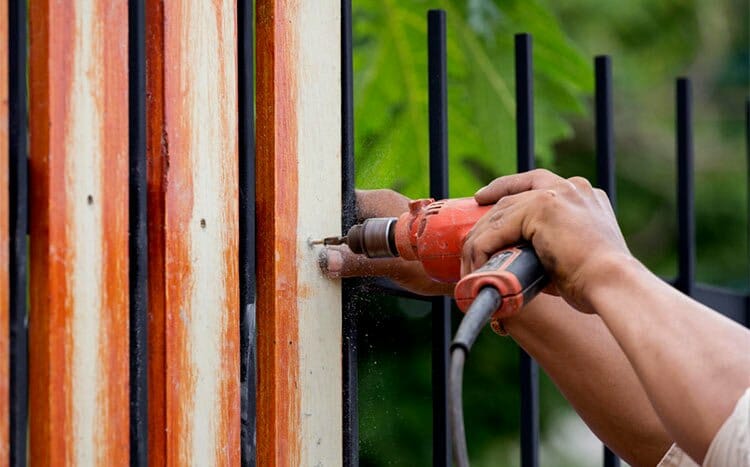Ohio stands out among a limited number of states in the US for revising its fencing regulations. In 2008, Ohio revamped its prior fencing statutes into what are currently referred to as ‘partition fence laws.’ The primary aim of these updates was to tackle contemporary disagreements between neighbors over property lines.
Therefore, before engaging with your neighbor about the fence on the property line, ensure you understand these new laws.
What we cover
ToggleDo I need a permit to build a fence in Ohio?
Confirm with your local regulations, but in most municipalities, you won’t need a building permit for a fence under 6 feet. However, getting a zoning permit might be compulsory for new fences depending on your location.
If you’re replacing the fence with similar materials, height and position, you may not need a permit.

How close to the property line can I build a fence?
Most local authorities allow you to build the fence right up to the property line, especially with the new law. However, some local town authorities still recommend a 3 feet setback.
Your neighbor or their contractor is also allowed by law to enter up to 10 feet into your property to build and maintain the fence.
Keep in mind; Some neighborhoods may have different regulations depending on the zoning and your Homeowners Association rules.
Illegal fences in Ohio
Under Ohio’s 2006 Revised Code § 971.03, all barbed wire, hedges, or electrified wire boundary fences are forbidden, unless one neighbor obtains written consent from the adjoining neighbor.
Live fences of any kind including willow, with the exception of Osage or blackthorn hedges, are also prohibited.
These laws apply to both commercial properties and individual landowners.
Fence upkeep/ maintenance laws Ohio
The laws regarding fence maintenance among neighbors in Ohio vary depending on your type of fence and its ownership.
For fences built on or after September 2008, all the new fence laws apply. Therefore, the builder of the fence will be responsible for its maintenance and upkeep under the ‘Rule of Individual Responsibility.’
Other fences built before September 30th, 2008 will be catered for and maintained by both adjoining neighbors. They will both share costs even if one landowner may contribute more than the other based on what is ‘fair’.
If your grazing property is next to a government fence, you may have to employ the ‘Rule of Equal Shares’ where both parties will share 50/50 of the cost of upkeep and maintenance.
Important: Not all properties in Ohio are covered by the Ohio Line Fence Law. Here are some of the types of property the law doesn’t cover:
- Fences within municipalities
- Fences to be constructed by an individual or corporation owning a railroad
- Fences between lands laid out in lots under Ohio Subdivision law.
- Line Fences subject to a written and recorded landowners agreement

Who owns the fence on property lines in OH?
Since the implementation of the revised partition laws, only the neighbor interested in installing the fence is recognized as the owner. The adjoining neighbor doesn’t have to contribute to the installation, maintenance, and repairs of the fence. This is called the ‘Rule of Individual Responsibility.’
For pre-existing fences (built before September 2008), the ‘Rule of Equal Shares’ applies. This law requires equal sharing of responsibility for the fence based on what it deems fair.
For instance, one adjoining neighbor may be responsible for 80% of the fence while the other 20% depending on how much benefit they get from the fence.
These equitable shares are determined by looking at:
- Topography of the fence’s location
- Risk of trespassers on either property due to population density
- The importance of marking boundary lines between the properties
- Number of livestock each neighbor owns
- Presence of water bodies like streams, rivers, etc. on the property
- Presence of trees, bushes among other vegetation on either property
Collectively, these are referred to as the six factors of ‘fairness’.
The only time you’re required to uphold the old fence law of joint ownership for property line fences is if your property neighbors certain government fences.
In such a case, you’ll be liable to maintain an equal share of the fence costs.
Can my neighbor build a fence on the property line?
Yes! The revised Ohio fence laws now allow your neighbor to build on the property line with zero obligations to you. As long as you don’t keep livestock on your property, there’s no obligation for you to contribute to that fence.
However, the law allows that neighbor to seek compensation for the costs of the fence if they can prove you used it within 30 years of its construction.
This is quite easy to prove if you have animals on your property.
Do I have to tell my neighbor I’m building a fence?
In most cases, yes! Even though the new law says that you’re fully responsible for any new fence you build, it’s still important to inform your neighbor.
Most homeowner association rules actually demand that you send the neighbor a written notice before construction.
Telling them beforehand also helps them understand why you and your contractors are ‘trespassing’ to their compound daily. (The law demands that they allow up to 10 feet).
If they have some livestock on the property, you also need to tell them so you can negotiate a fair equitable shares deal.
What if my neighbor won’t pay half?
Your neighbor doesn’t have to pay if it’s a new fence. The new partition fence laws abolished the old ‘equal partners’ right that required adjoining neighbors to share responsibility for the line fence.
If the fence was built before 2008, your neighbor may also not have to pay 50% based on the ‘Rule of Equal shares’. You’ll have to first prove that the neighbor benefits just as much as you from the fence to demand half the costs.
The partition fence laws provide two key ways in which Ohio residents can settle such a fence dispute. You can choose to submit the issue to the local town’s council of trustees, or file a suit at the court of common pleas.
It’s always advised to start with your local county trustees. They’ll consider the six critical ‘fairness’ factors, then determine the responsibility range for each neighbor on a scale from 0 – 100% or 50-50.
If you’re not satisfied with their decision, you can then file a lawsuit.
Ohio Property encroachment laws
The Ohio partition fence laws work on the notion that a landowner doesn’t have to take any drastic measures to prevent encroachment from their land. Even if a neighbor has encroached on your side of the property by accident, the law allows you to sue them for trespassing.
The fence laws also allow the loss of encroached land through adverse possession. For example, if your neighbor builds a fence over the property lines into your property, they have the right to claim that portion of the disputed land after at least 21 years.
To avoid this loss, always hire a land surveyor to determine the property lines of the properties you purchase.
Ohio boundary fence laws at a glance
This table provides an overview of some of the state laws governing Ohio fence law and links to their original documents.
| Statutes | Fence regulations by city |
|---|---|
| Ohio Code § 971.05 Partition fence law Ohio Code § 971.06 Maintaining existing fence Ohio Code § 971.03 Illegal fences in Ohio | City of Columbus fence ordinances City of Cleveland Fence Regulations City of Lancaster Fence Regulations City of Canton Zoning Department |
Keep in mind; These laws are bound to change with time depending on the new legislation, federal court decisions, and other initiatives. Use the information provided above as a guide and research the latest regulations in your municipality.
FAQ's
Who gets the good side of the fence?
The good side should always be facing your neighbor. This is usually a regulation for most HOA and local authorities but not the entire Ohio state. In most municipalities, this decision boils down to you.
Letting the good side face your neighbor offers you so many benefits. For instance, it helps improve your neighborly relationship and also makes the house look more appealing to potential buyers.
Can a neighbor remove a fence?
It depends. Under the old law, your neighbor couldn’t do anything to the fence without asking you for permission. But now with the new law, if you built the wall, it’s yours. The neighbor can’t remove that fence.
If you’re both using the fence under the Rule of equitable shares, you’ll have to come to an agreement before the neighbor can remove it.
Under Ohio Revised Code § 971.17, the neighbor will also have to give you a 28-day notice before removing the fence.
Can I build a fence next to my neighbors’ fence?
Yes! As long as you observe the property line between your properties, you can build a fence next to your neighbor’s. However, you’ll still have to observe the HOA regulations in your area that may govern the color, height, and appearance of the fence.
While doing this isn’t the best way to save money, building a fence within your property line may give you the artistic freedom, and privacy you need.













